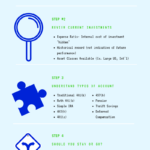You have how many old 401(k)s or retirement accounts? It’s really easy to have multiple 401(k)s out there from previous employers and feel overwhelmed with keeping track of them. Whether you have one or many accounts floating around out there, this guide will help you determine what your options are.
Cheat Sheet

Fast Travel Links
Step 1. Find Out Where Your Old Account is Held.
The easiest way to find this out is to check for an old statement. Most statements should come through the mail on at least a quarterly basis. If you haven’t received recent statements, then you may have previously enrolled in electronic statements. If neither of these options bares fruit, then you might have to do additional research. If you still are in contact with previous coworkers, see if they know the company that holds your old employers’ retirement account. You can also contact your old employers’ HR department.
Step 2. Review Your Current Investment Options
If your old employer allows you to keep your account within their plan, then you may want to review the investment options that they provide. It is possible they may have better investment choices than what your new employer provides. Although they may allow you to keep your account within their plan, you will not be eligible to make new contributions.
Things to look for:
- Expense Ratio – No your retirement account is not free, the cost of your retirement account is hidden in your investments. Expense ratios can vary greatly from 0.01% to over 2%. The average tends to be north of 1%, but have been slightly improving recently.
- Historical Track Record – Though past performance is not indicative of future performance, it still is a little more comforting to see that the investment has performed in the ballpark of similar asset classes.
- Asset Classes– Generally, it is recommended to diversify your investments across many asset classes so that you’re not overexposed or underexposed to market losses and market growth. One problem that occurs within employers’ retirement accounts is that they provide great investment choices for only a few asset classes, but then have poor options in others. Example: US Small Companies or International Investments with high fees or poor management
- Site Accessibility– Most sites have finally caught up to modern-day user-friendly sites to navigate, but that’s not always the case. If you are unable to keep track of your account because of the stress of navigating a poorly laid out site, then you may be better off moving the account elsewhere.
- Review Annually- Not only can your old employer move the plans to another company, they can also change the investment options within the plan. If you wish to leave the assets in your old employer plan, major changes may lead you to want to make a change in the future.
Step 3. Understand the Type of Account You Have
Before we can discuss the potential impacts of transferring or withdrawing your assets, it’s important to create a baseline for some of the lingo you’ll run into.
I’ll refer to the following as Traditional:
Pre Tax = Traditional = Taxes haven’t been paid = Taxes need to be paid upon withdrawal
Examples: Traditional 401(k), 401(k), 403(b), 401(a), 457(b), Traditional IRA
I’ll refer to the following as Roth:
Post Tax= Roth (most of the time) = Taxes have been paid = No future income tax impact
Examples: Roth 401(k), Roth 403(b), Roth IRA
Step 4. Should I Stay or Should I Go?
If you decided to stay, then reviewing annually to make sure there are no significant changes and to monitor your progress should be your next course of action.
If you decide to leave the old plan here are your options:
Cash Out
Most retirement accounts are traditional. In addition to withdrawals being taxable income, there is also a 10% penalty for early withdrawal, which is most withdrawals made before age 59.5. There are a few rare situations where this wouldn’t apply. Most accounts will automatically withhold 20% on your distribution to help account for the taxable income and penalty, but if your tax bracket is on the higher end, you may want to opt for a greater amount to be withheld.
If you had set up your account to be a Roth, then your contributions into the plan can be withdrawn without penalty in addition to not being considered taxable income because you’ve already paid taxes on the funds before they were contributed to the account. However, there still may be an early withdrawal penalty of 10% on any gains from your contributions that have accumulated in the account when they are withdrawn.
Even if you made Roth contributions, if your employer made any contributions into your account, they are always classified as traditional funds, which means you have both types of funds in the account. Most retirement plans don’t do a good job in breaking these numbers out on your website, but they are required to when you make withdrawals.
COVID-19 Update
As a part of the CARES Act, Distributions from your retirement accounts in 2020 may not be accessed a 10% Penalty. To avoid the 10% penalty, you will need to have been adversely impacted by COVID-19.
Rollover to New Plan
You’d want to take the same process for Step 2 with your new employer’s retirement plan. If you decide that the new plan would be better than your old one(s), then you’ll want to first verify that your new plan accepts rollovers and if the types of plans match. Traditional -> Traditional or Roth -> Roth.
Unless the type says ROTH, nearly all retirement plans are Traditional by default.
Contact the old company that holds your old retirement account and request them to “Rollover” your account. It’s critical to use the term “Rollover” so that they understand that you’re not cashing out the account. If it is processed as a “Cash out” then taxes will be withheld and it creates a logistical mess. A rollover allows your funds to transfer with no tax impact.
Typically, once you rollover to your new employer plan, the funds will not be able to be transferred out until you separate from employment. If there is some reason you would need more flexibility to withdraw your funds, then an IRA or Roth IRA may be a better fit.
Rollover to IRA or Roth
If you’re not satisfied with either of your employer plan options, then you may want to look at self-directing your investments. This option definitely gives you the most flexibility with investment choices as you have practically an unlimited amount of choices. Some are overwhelmed with their options and choose not to go this route.
Similar to what I mentioned in matching the types of accounts between employer retirement plans, you’ll want to usually transfer between like account types. Traditional -> Traditional Roth-> Roth
Advanced: Roth Conversion
This would be classified as a Level Up Financial Planning Strategy. Instead of matching up like type accounts you would be making a strategic decision to transfer from a Traditional -> Roth. Yes, you’d end up paying taxes in the year that you make this conversion, but you’ll never have to pay taxes on those funds again. When you are doing a conversion there is also no penalty since the funds are still staying within retirement accounts.
The hope is that you’ll have tax free growth that you can withdraw when you retire. You’re betting that the tax is better to be paid now than in the future when you retire. There are some scenarios when it may be more obvious a choice, for example: transitioning between jobs that will result in lower income during a tax year due to an employment gap.
Combination of Any of the Above
The only reason why you’d use a combination approach is if you’re doing so for strategic reasons. A Roth conversion is a very strategic maneuver, but you may not want to convert your whole account because of the tax consequences. There may be additional paperwork needed or you may have to be very clear with the previous retirement account company if you are requesting by phone to make sure they handle the transactions accurately.
Conclusion
Finding out what you have and where it is, happens to be the most difficult step in the financial planning process. Once you get over the hurdle of Step 1, the rest of the process feels drastically easier.
If you are struggling with understanding any of the above areas don’t hesitate to reach out. I love helping people with any financial topics whether they be basic or advanced.
Connect with Level Up Financial Planning on any of our social platforms: LinkedIn Facebook Twitter

Lucas Casarez is a Certified Financial Planner™ Professional serving tech professionals virtually out of Fort Collins, CO
